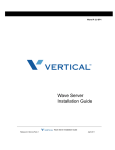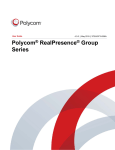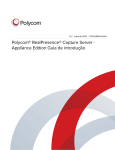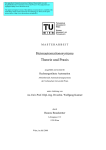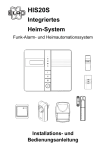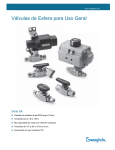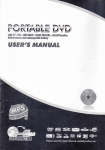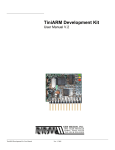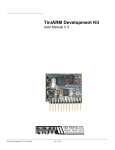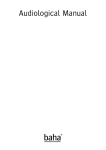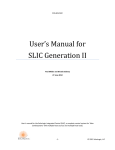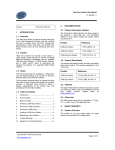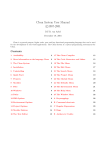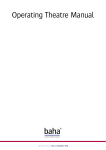Download Powerline Applications European Home Systems (EHS)
Transcript
Powerline Applications with European Home Systems (EHS) Dip1.-Ing. Ludwig Brackmann, ATICON Home Automation GmbH presented at: International Symposium on Powerline Communication and its Applications Essen, Germany, 2-4 April 1997 Abstract , This paper presents in the first part a measurement system for the powerline medium. The Powerline Communications Analyzer (EHS-PLCA- 1) is able to do short term and long term measurements on the powerline measuring the signal level and the noise level in the frequency band used by powerline communication. In the second part powerline applications based on the European Home Systems (EHS) standard are presented: The given examples include white goods (Miele washing machineldishwasher), intelligent plugs, a TV user interface and telephone gateway to the EHS powerline medium. Also a powerline gateway solution to the European Installation Bus (EIB) is given. In addition to this paper Dip1.-Inform. Gerrit Telkamp, ATICON Home Automation GmbH, will give a presentation titled 'A Low Cost Powerline Node for Domestic Applications'. I 1 1 Introduction Home automation products need to communicate amoung each other to form a home system. In addition to radio frequency the powerline medium is the most suitable medium for different reasons. Home automation products for retrofitting applications (e.g. zone heating, light . control or security) can be installed without extra and expensive cabeling; products movable by the end user can be moved during their livetime and easily reinstalled by the user (white goods, user interfaces). I I I , 2 Powerline communication according to the EHS standard The European Home Systems standard [I] defines installation procedures called registration and enrolment to offer plug&play installation. This feature is very important for home automation products using the powerline medium as those devices can be installed and deinstalled at any time by the user. More details about the EHS protocol can be found in [1,2,3]. I I 3 The Powerline Communications Analyzer EHS-PLCA-1 As the power line changes it's characteristic for communication depending on the time of day and the day of the week there is a need to do short and long time measurements to be able to decide whether reliable power line communication can be used in an industrial or residential application. The EHS-PLCA-1 is designed to do measurements with up to 4 satellite stations over a time period of more than 10 days. Thus the changing transmission characteristics between working days and the weekend can be revealed. The PLCA can also be used in February 1997 ATICON Home Automation GmbH page 118 Powerline Applications with European Home Systems (EHS) , laboratories or test sites to learn about the powerline and the influence of home appliances and other devices on th'e powerline communication. The EHS-PLCA-1 can be used for consumer band communication (CENELEC C-band). Measurement data gained with the EHS-PLCA-I is also useful when working with different powerline system using the C-band. Adaption for utility communication (CENELEC A-band) will be done in the future. \ ' 3.1 The main Features of the EHS-PLCA-1 The powerline communication analyzer system EHS-PLCA consists of a master station EHSPLCA-1 and up to four satellite stations EHS-PLCA-IS. There is a power cable for each station. In addition the master station includes a serial communication cable and a disk with a data transfer software (terminal program). 3.1.1 Master Station EHS-PLCA-1 The power line communications analyzer master station EHS-PLCA-1 has a small size of 200 mm * 120 mm 7 60 rnrn.It has a powerline connector, a BNC connector and RS232 connector. The user interface is realized with a graphical LCD display and four context. sensitive keys. The LCD with backlite enables operating also in dark environment. The backlite has auto power off to reduce current consumption. RS232 63n coax (BNC) connector J-powerline connector c----- ON, key no - -- -- -- .-- -- -- -- - - Powerline Applicationswith European Home Systems (EHS) 3.1.2 Satellite Station EHS-PLCA-1s The power line communications analyzer satellite station EHS-PLCA-1S has a small size of 200 mm * 120 mm * 60 mm. It has a powerline connector, a pow connector and RS232, connector. The satellite station has no user interface except of the LCD display as all kind of configuration can be done remote controlled from the master station. The LCD wiq backlite enables reading also in dark environment. This backlite has no auto power off. S dU coax (BNC) connector J- powerline connector - no. of station i Figure 3.2: The satellite station has a 2*16 alphanumeric LCD with backlite. Configuration and operation is done remotely from the master station. The number of the satellite station (1 to 4) is set intemaly and displayed in the top right comer of the display. I II , I I 3.2 Measurement Examples and Interpretation In this chapter two measurement example are given. The first shows measurements in an appartement house, the second in an office building. 3.2.1 ~easurementsin an Appartement House The chosen'appartement house has ten appartements, each of a size of 60 m2. Each plant has two appartments. The electric meters are placed in the basement. From the basement an extra wiring with three phases runs to each appartment. So the way of wiring has a star shape. To run the measurements the PLCA master station was placed in the kitchen at the ground floor. The slave no. 1 was placed in the livingroom. The distance between theese two devices was approx. 6 m. .w. , T--------- - -- -- -- Powedie Applications with European Home Systems (EHS) The following tabel (Tab. 3.1) shows the measurement data. t ' Tab. 3.1 EXCEL-File with measurement data (beginning only) measurement values seen by the slave Figure 3.3 measurement values seen by the master Communication between the master (ground floor) and slave 1 (ground floor) In figure 3.3 you can see, that the carrier signal between the master and the slave no. 1 is attenuated by approx. 20 dB. From 22:30 h to 23:30 h a television set (NORDMENDE T4030) was switched on in the living room. It is interesting to notice that this has different impact on the attenuation of the two directions of transmission. The slave receives the signals of the master station attenuated by 5 dB but the master station gets a signal amplified by 5 dB. -- - - - -- - - w , . Powerline Applications with European Home Systems (EHS) Directly next to the slave station no. 1 a notebook with external power supply was running from 8:30 h to 22:00 h. The emitted noise spectrum can be clearly seen in the according frequency band. At the master station the noise level is lower than the PLCA can measure. The slave station registered a noise signal level of approx. -70dBpV. Further more it can be seen that the TV-set transmitts conducted interference also. During the whole measurement period cornmnnication was possible without any disturbance neither because of too small receiving signal levels nor because of too high noise levels. 3.2.2 Measurements in an Office Building The power supply network of this office building has a shape of a star starting from one central service room. In the building there are a lot of potential noise emitting and attenuating devices.. Some of them could be identified: - fluorescent lamp - computers - electrical motors - frequency.converters The master station was placed near the central service room. Three slave stations were placed about 10 meters away from this room in different offices. When people start working in the morning the noise level at the master stations location near the central service room increases evidently. A very interesting effect shows up at approx. 1390 h: For about one hour the registered signal level rises above the signal level measured when the office was closed. The reason is not known yet, measurement dath seen by the slave 1 9 2 1 2 3 1 3 5 7 9 1 1 U l 5 1 7 1 9 measurement data seen by the master 192123 btl Figure 5.3 I I , I I I 1 3 5 7 9 11 I3151719 cm Communication between master and slave 1 The presented measurements show theat the communication characteristics changes a lot during the day. The logged data also shows that the minimum difference between carrier signal level and noise level is always more than 20 dB. Resuming the measurements one can say that a safe powerline communication is possible at any time in the areas examined. -- I 'i . 4 Powerline Applications Inside the Home 4.1.1 A Miele washing machine and dishwasher communicating via powerline Using the ATICON Intelligent Appliance Interface EHS-IAI-1 domestic appliances can be made communicating according to the EHS standard. The module is adapted to the serial interface of the home appliance and converts the information of the appliance to the EHS t command language using EHS objects and vice versa. I Intelligent domestic appliances can communicate with a load management controller to do peak load management or adj,ustthe time they are working to a period of lower electricity tarrifs. Further more they can inform their owner about unwanted situations (alarms, malfunction, false operation by the user). The user can paramerize the load managrnent system using e.g. a TV user interface. .feature controller load management lV user I ! EH I ! I 1 I I Figure 4.1: This figure shows a load management system based on the European standard for home automation (EHS). ATICON has implemented mayor parts of this systems for different manufacturers. Applications are load management for white goods, remote access via telephone gateway and visualization and control of the home system using a N user interface or PC user interface. 4.1.2 A TV User Interface for the Intelligent Home The TV user interface is a low cost set top box for any kind of television set that gives the user easy possibility to control his home automation system. The functions are available by using intuitively graphic menus. Switch buttons can be used for light control, sliders for temperature and time control setting. Information and warning messages can be displayed while watching TV. The utility or housing company can provide realtime data on electricity, gas or water consumption and send personal or broadcast info-messages. The TV user interface is connected to a conventional TV set via the SCART connector and uses an IR remote control for inputs. In order to be able to build an universal and flexible TV user interface it is necessary to have a small and efficient page description language for pages to be displayed on the TV user interface. As the functions of future devices are not know at the moment the domestic appliances have to inform the user interface about their functions and the screen layout at the -- - - - - .--- ---- - -- -- -- - .. , , , " ,,. .. , * , - - Powerline Applications with European Home Systems (EHS) moment of their installation at home. A configuration using a PC and a CD is not comfortable. So all the necessary information has to come from inside the domestic appliance, from the intelligent appliance interface EHS-IAI- 1 and has to be transmitted via the slow medium powerline. All these contraints and demands ask for a page description language using very small resource in terms of memory. Fig. 4.2: The TV User Interface TVUI-1 uses the familiar television set to control the intelligent home. This page show how to control the washing machine from the living room. 4.2 Zone Heating System Zone heating is not only a powerline application in the retrofitting market. As the power for operating the valves comes along the same cable as the control data powerline communication has a big advantage here. A small and cheap system with four valves, four temperature sensors and a heating controller can safe upto 30 percent of energy. In retrofitting application it is easier to install some new power plugs next to some radiators than to cable the whole appartment or home. 4.3 Remote Access to the Home via the Telephone Nehnrork (PSTN) Several application areas ask for remote access to the home via the telephone network. Some of them are: Remote diagnostics of the heaing system & white goods, remote surveillance and control (whole house), alarm messages (heaing system & white goods). 4.4 A Gateway between the media EIB Twisted Pair anq EHS Powerline User Interfaces like a TV user interface should be relocateable at any time by the user. Also in new homes equipped with twisted pair bus cabel there are still more electric power outlets As the user wants to be able to change the position of his user interfaces than bus ~on~ectors. (TVuser interface,'PC, small LC displays with some keys, sirene, ...) there has to be a gateway between the twisted pair installation bus tmd the powerline at some suitable central point. \ r --w-- - - -- Powerline Applicationswith European Home Systems (EHS) I 5 Literature . 1. Telkamp, G.: 'A Low Cost Powerline Node for Domestic Applications', International Symposium on Powerline Communication and its Applications, Essen, 1997. 2. European Home Systems specification 1.3, European Home Systems Association, Brussels, 1997. \ ' 3. Kung, u.a.: The European Home Systems Network, Vertrieb: ATICON. 4. EHS-PLCA- 1, Powerline CommunicationsAnalyzer System for Short & Long-Term Measurement, User's Manual, ATICON Home Automation GmbH, Braunschweig, 1996. 5. Proceedings: Conference on ‘European Home Systems - Das intelligente Haus wird Wirklichkeit', SGS-Thomson Microelectronics, ATICON Home Automation GmbH, 1995. 6. Brackmann, L:: Das European Home Systems Protokoll, Conference 'European Home Systems - Das intelligente Haus wird Wirklichkeit', Braunschweig, 1995. 7. Proceedings: Conference on 'Applications for Intelligent Living in Private Homes', Institut fiir Elektrische MeBtechnik, TU Braunschweig & WX/VDE-IT, Braunschweig, 1996. 8. Brackmann, L.: User Interfaces for Intelligent Homes, Conference on 'Applications for Intelligent Living in Private Homes', Braunschweig, 1996. 9. Telkamp, G.: RF Transceiver for a Common European Standard, Conference on 'Applications for Intelligent Living in Private Homes', Institut fiir Elektrische MeBtechnik, TU Braunschweig, VDINDE-IT, Braunschweig, 1996. lO.Happacher, M.: Eine gemeinsame Sprache: Die Busse der Heimautomation auf dem Weg zur Einheit, Elektronik, 411997.








